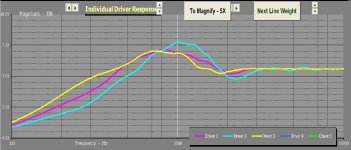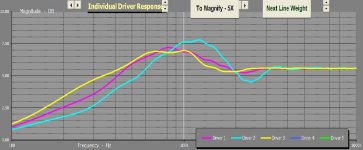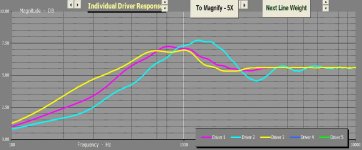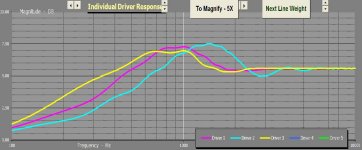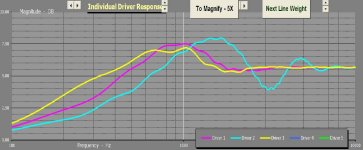I have thought alot about you peoples advice regarding size of woofer and mid cabinets.. I still don't want monster speakers, but i still decided to change the design a little. I made the speaker slightly wider and taler. as a result the internal volume is now a total of 35L.
Now the question is how to use it. Based on the idea of the flow resistor the design now looks like this:
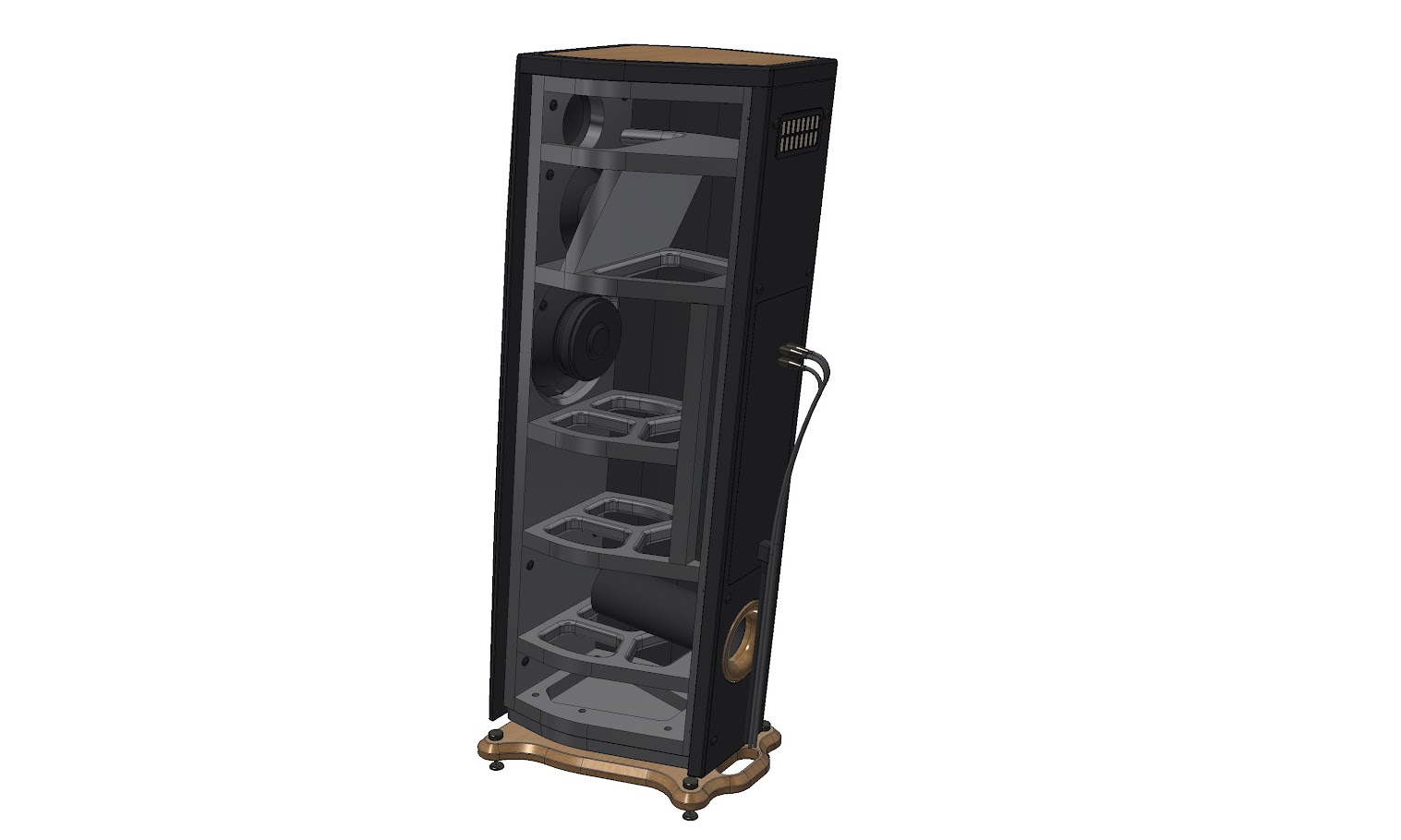
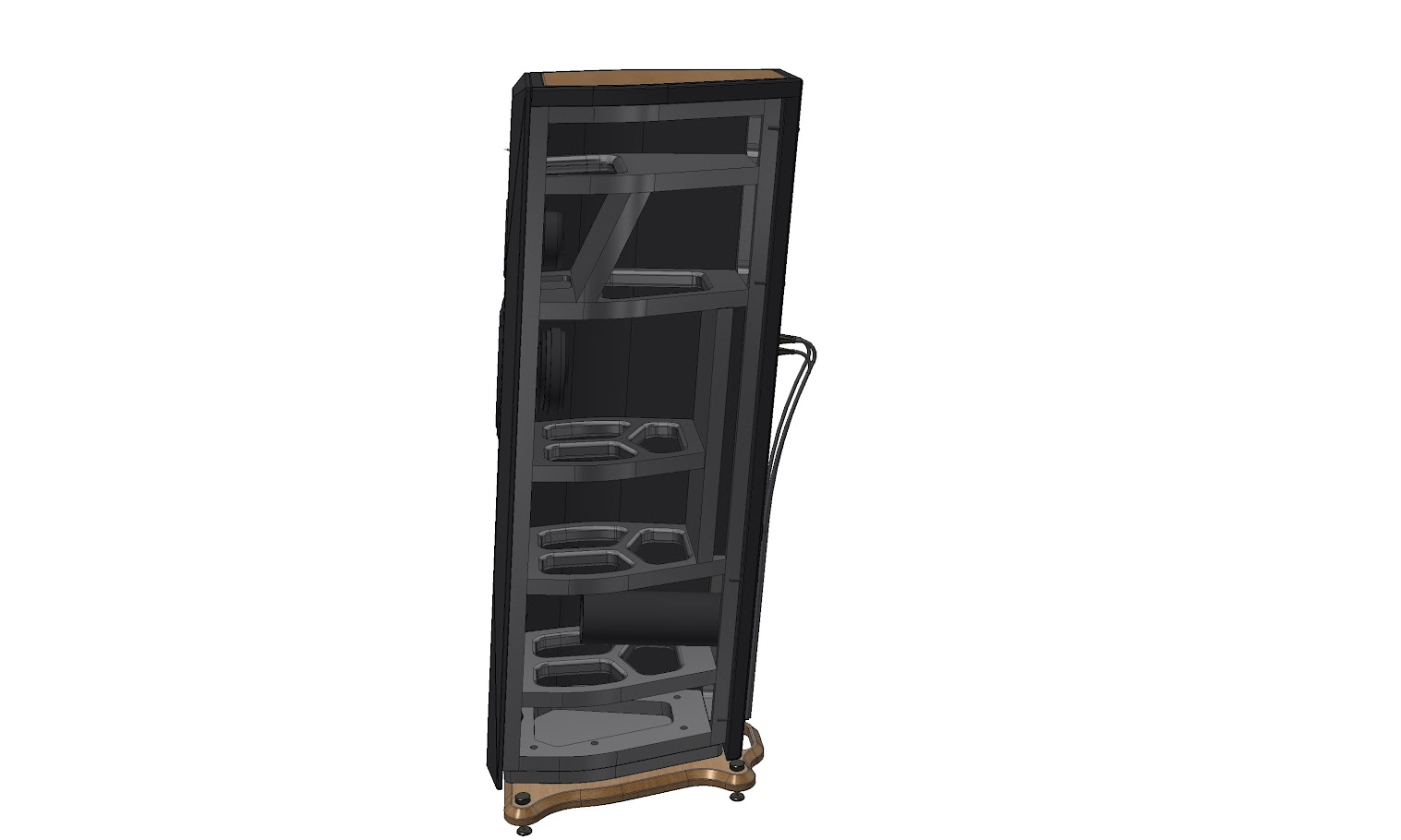

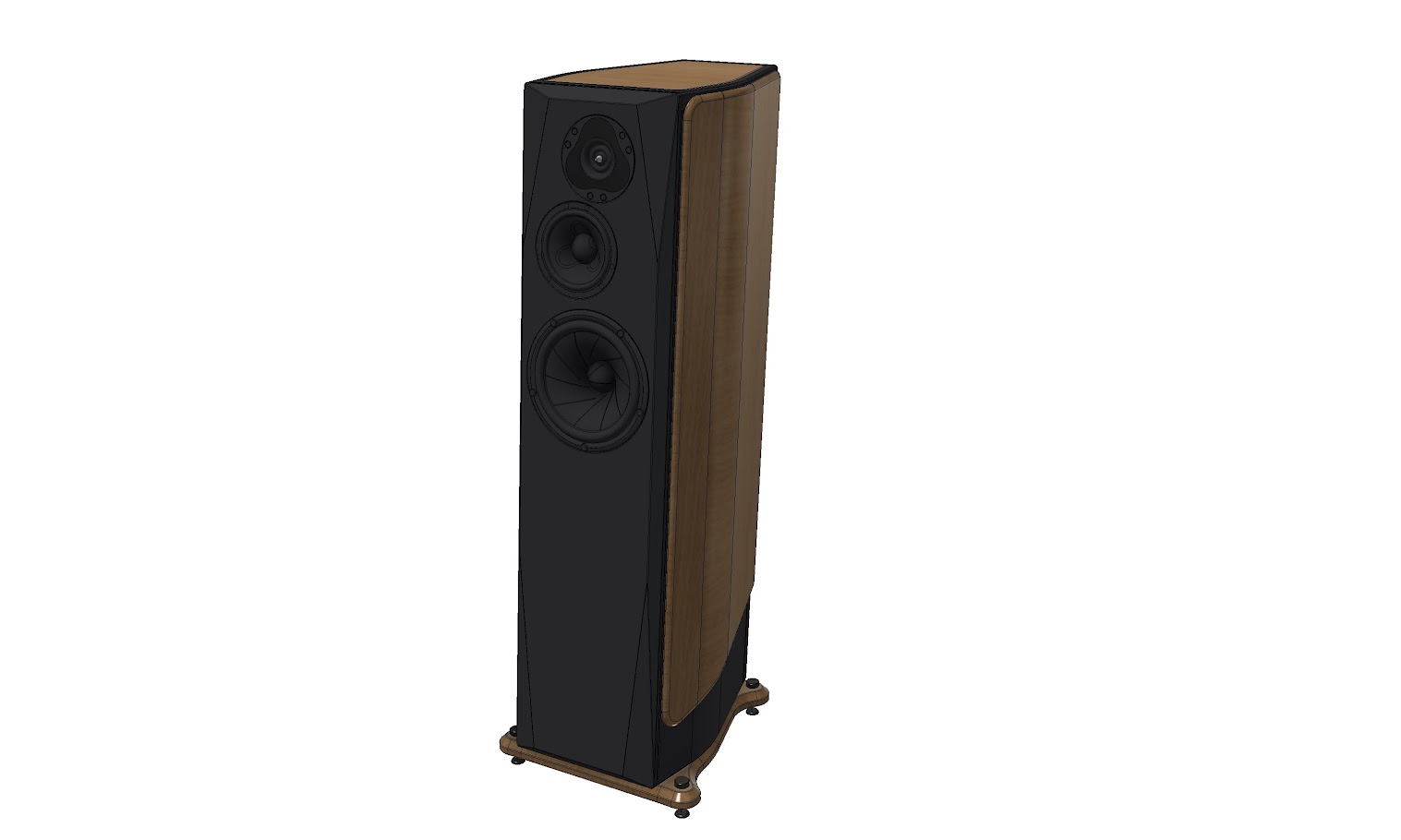
This will give me 28,6L for the woofer and around 6L for the mid.. This mid cab is way bigger than it needs to be but it will allow me to experiment with a flow resistor in the back as shown here. The questionis then.. Is this mid cabinet a good design or am i still cramping the mid-driver to much?
#jReave - Thanks for the second look! I hope it won't die yet, maybe sleep for a while
I actually also thought about isolating the tweeter from the woofer chamber as i think the tweeter is thin and would guess some sound could pass through. However, as you say not many designs has this. But in the design above the tweeter is now in the mid cabinet. I guess this is still better than with the woofer right? Or would you still seal it completely for it self?
I also added a extra piece of bracing, or did you rather mean right behind the woofer itself?
Again thanx alot for thefeedback! All of you!
Now the question is how to use it. Based on the idea of the flow resistor the design now looks like this:
This will give me 28,6L for the woofer and around 6L for the mid.. This mid cab is way bigger than it needs to be but it will allow me to experiment with a flow resistor in the back as shown here. The questionis then.. Is this mid cabinet a good design or am i still cramping the mid-driver to much?
#jReave - Thanks for the second look! I hope it won't die yet, maybe sleep for a while
I actually also thought about isolating the tweeter from the woofer chamber as i think the tweeter is thin and would guess some sound could pass through. However, as you say not many designs has this. But in the design above the tweeter is now in the mid cabinet. I guess this is still better than with the woofer right? Or would you still seal it completely for it self?
I also added a extra piece of bracing, or did you rather mean right behind the woofer itself?
Again thanx alot for thefeedback! All of you!
Free lunch for sure!
I disagree.... Check out the attached sim I did for another DIY member who wanted high SPL at 40Hz.
In just 2 cubic feet with a critically damped Q of 0.5, this Precision devices driver does 115dB at 40Hz, 110dB at 30 Hz and 105dB at 20Hz.... All continuous (AES).
6dB peaks above these levels are available..... Plus check out the amazingly low power compression even at full (1Kw) power.
Just 2 cubic feet with a critically damped Q of 0.5.
Full technical background to this well established "ELF" (Bag End Subwoofers) principal are available from Rod Elliot here:
Sub-Woofer Controller
I would avoid the undersized-box approach.
Professor Linkwitz recommends a Qtc in the critically-damped range.
There is no free lunch, even with DSP.
I disagree.... Check out the attached sim I did for another DIY member who wanted high SPL at 40Hz.
In just 2 cubic feet with a critically damped Q of 0.5, this Precision devices driver does 115dB at 40Hz, 110dB at 30 Hz and 105dB at 20Hz.... All continuous (AES).
6dB peaks above these levels are available..... Plus check out the amazingly low power compression even at full (1Kw) power.
Just 2 cubic feet with a critically damped Q of 0.5.
Full technical background to this well established "ELF" (Bag End Subwoofers) principal are available from Rod Elliot here:
Sub-Woofer Controller
Attachments
I disagree....
With what do you disagree?
On a side note, the 18W/x531 series is my single most favorite driver of all time. I am listening to a pair in my large standmounts, crossed over to Mundorf AMT's around 2 kHz and I am in absolute heaven.
It is almost a waste to treat them as pure woofers. Also, as I have written and proven elsewhere, the FR on them is MUCH better than spec. Be prepared!
It is almost a waste to treat them as pure woofers. Also, as I have written and proven elsewhere, the FR on them is MUCH better than spec. Be prepared!
#eriksquires - I never heard a wide baffle speaker, but i sure also don't have the space for such a thing 
Glad to hear you like the 18W! When i look at your stand mount i wonder.. Why is it so hard for me to get 28 L from a floor stander.. your speaker looks super tiny! But i guess it ain't..
I completely agree that it is a shame to treat them with no respect, which is exactly why i am rebuilding my speakers
You wouldn't know where i could find more close to reality specs on the woofer would you?
Glad to hear you like the 18W! When i look at your stand mount i wonder.. Why is it so hard for me to get 28 L from a floor stander.. your speaker looks super tiny! But i guess it ain't..
I completely agree that it is a shame to treat them with no respect, which is exactly why i am rebuilding my speakers
You wouldn't know where i could find more close to reality specs on the woofer would you?
BTW. I am still not sure I fully understand these diffraction simulations entirely.... But it seems that the driver positions showed above actually creates a pretty decent result. The only software i tried so far though is the VituxCAD.
#jReave - The Baffle Diffraction Simulator you linked to, is that supposed to just be a excel spreadsheet? Or is there some kind of compatibility issue with windows 10?
#jReave - The Baffle Diffraction Simulator you linked to, is that supposed to just be a excel spreadsheet? Or is there some kind of compatibility issue with windows 10?
Small sealed box design advantages
I disagree with your advice to "avoid the undersized box approach"
Worth clarifying a few points:
(1) The loading technique I describe is NOT an "undersized box".
(2) It is a correctly sized box for achieving the most accurate performance from any driver ie no delayed resonance ports / transmission lines / passive radiators.
(3) It is best suited to Pro drivers with very powerful motors (high Bl), low Mms, low Qts and large voice coils (low power compression).
(4) It is easy to vary the system Q from 0.5 up to 0.707 depending on system requirements and matching mid-range drivers.
(5) It is easy (and cheaper) to build a small non resonant box.... Large panels resonate a lot!
If you read the Rod Eliot article I linked to it explains the technique in more detail, but his conclusion (after 20 years of ports / TL and passive radiator loudspeakers) is:
" Overall, I would have to say that I doubt that any conventional design would be as compact, or would have such clarity and solidarity. Being a sealed box, there is none of the "waffle" that ported designs often give, and the speaker is protected against excessive excursion by the air pressure in the box itself (below the cutoff frequency, anyway).
The bottom end in my system is now staggering. It is rock solid, and absolutely thunders when called upon. The 400W amp is more than sufficient for the job, considering it has to keep up with a biamped main system capable of very high SPL (up to 120dB at my listening position)...."
The attached John Wilkinson article explains in detail how the Human Auditory System ( HAS) works and why sealed box loading (or open baffle if done correctly) is always more accurate than the fundamentally flawed delayed resonance ports / transmission lines / passive radiators / back loaded horn systems.
With what do you disagree?
I disagree with your advice to "avoid the undersized box approach"
Worth clarifying a few points:
(1) The loading technique I describe is NOT an "undersized box".
(2) It is a correctly sized box for achieving the most accurate performance from any driver ie no delayed resonance ports / transmission lines / passive radiators.
(3) It is best suited to Pro drivers with very powerful motors (high Bl), low Mms, low Qts and large voice coils (low power compression).
(4) It is easy to vary the system Q from 0.5 up to 0.707 depending on system requirements and matching mid-range drivers.
(5) It is easy (and cheaper) to build a small non resonant box.... Large panels resonate a lot!
If you read the Rod Eliot article I linked to it explains the technique in more detail, but his conclusion (after 20 years of ports / TL and passive radiator loudspeakers) is:
" Overall, I would have to say that I doubt that any conventional design would be as compact, or would have such clarity and solidarity. Being a sealed box, there is none of the "waffle" that ported designs often give, and the speaker is protected against excessive excursion by the air pressure in the box itself (below the cutoff frequency, anyway).
The bottom end in my system is now staggering. It is rock solid, and absolutely thunders when called upon. The 400W amp is more than sufficient for the job, considering it has to keep up with a biamped main system capable of very high SPL (up to 120dB at my listening position)...."
The attached John Wilkinson article explains in detail how the Human Auditory System ( HAS) works and why sealed box loading (or open baffle if done correctly) is always more accurate than the fundamentally flawed delayed resonance ports / transmission lines / passive radiators / back loaded horn systems.
Attachments
#eriksquires - I never heard a wide baffle speaker, but i sure also don't have the space for such a thing
Glad to hear you like the 18W! When i look at your stand mount i wonder.. Why is it so hard for me to get 28 L from a floor stander.. your speaker looks super tiny! But i guess it ain't..
It isn't. It is very deep. Lee Taylor suggested I should make them floor mounted. It is basically the Klang Tong Nada cabinet:
NADA 2-Way Klang + Ton Kit Pair using Illuminator Drivers
I completely agree that it is a shame to treat them with no respect, which is exactly why i am rebuilding my speakers
You wouldn't know where i could find more close to reality specs on the woofer would you?
The T/S parameters are a little off, but that's not what I meant. What I meant was the top end response is a lot smoother than the FR chart for it. I posted a thread here:
AHA! - ScanSpeak mid-woofs do measure better!
Otherwise, I recommend going by Madisound's volume/port recommendations (which line up with the Nada) and you'll be in a good place. As I recall, most of the T/S parameters are correct except for Fs, which is usually higher than specifiied. Troels did some investigation into this, and break-in and there's been plenty of discussions here about SS woofers vs. T/s specs too.
Last edited:
Before anyone jumps in:
Yeah, I know, my work was with the Revelator, the Klang Ton Nada is with the Illuminator, however examine the Madisound recommended cabinet data and you'll see why I say it's practically the same cabinet. Very little difference in volume/port recommendations.
Best,
E
Yeah, I know, my work was with the Revelator, the Klang Ton Nada is with the Illuminator, however examine the Madisound recommended cabinet data and you'll see why I say it's practically the same cabinet. Very little difference in volume/port recommendations.
Best,
E
As you know, I was not responding to your design when I made my comment, yet you seem to be using your design as some counter-evidence to my statement.I disagree with your advice to "avoid the undersized box approach"
Worth clarifying a few points:
(1) The loading technique I describe is NOT an "undersized box".
If you are "NOT" using an undersized box, then it doesn't seem that you disagree with my advice to avoid them, does it? Seems like you are, in actuality, avoiding the use of an undersized box, doesn’t it?
Perhaps you are confusing "undersized", with "compact". The former would refer to a box with a volume smaller than would otherwise be optimal. A huge box with a Qtc of 1.0 would be still be “undersized” for the present purposes.
ErikSquires recommended using an “undersized” box. though he didn't provide specificity.
Undersized Box = High Starting Qtc.
The problem is that a high starting Qtc and attendant transient- and frequency response realities are effectively impossible to “correct” in the equalization algorithm. More flexibility in the DSP does not overcome these issues, hence my “no free lunch” comment.
BTW. I am still not sure I fully understand these diffraction simulations entirely.... But it seems that the driver positions showed above actually creates a pretty decent result. The only software i tried so far though is the VituxCAD.
#jReave - The Baffle Diffraction Simulator you linked to, is that supposed to just be a excel spreadsheet? Or is there some kind of compatibility issue with windows 10?
Re diffraction,
Yes BDS is simply an Excel spreadsheet and yes problems have cropped up with Excel as MS has updated its operating systems. I am unsure about windows 10 as I am an old dinosaur still using XP. Maybe this thread will be of some help.
Not familiar with VituxCAD but looking here, it appears to be able to do the same thing as the Baffle Diffraction Simulator and a bit more - actually very similar to The Edge but with actual edge manipulation available. Again still not able to sim your style of chamfered edges perfectly.
Below and attached are some further examples from BDS with again a 7" width at the top, all drivers centered: (tweeter = blue, mid = purple, woofer = yellow and be sure to note the scale)
1 - chamfer = .5" with tweeter 3" and mid 7.5" from the top
2 - same as above with chamfer = 1.5"
3 - chamfer = 1.5" with tweeter 4" and mid 8.5" from the top
4 - chamfer = 1.5" with tweeter 5" and mid 9.5" from the top
5 - chamfer = 1.5" with tweeter 6" and mid 10.5" from the top
Conclusions:
- I did actually change the woofer position once or twice but it's all irrelevant since there is no significant change below your intended xo frequency
- changes to the mid response between about 700Hz and 3000Hz are larger but also so small as to not matter very much
- so it's all about the tweeter here. The difference between a .5" and a 1.5" beveled edge is significant - larger is better. And for the smoothest tweeter response above about 2000Hz, a lower height from the top edge is better although pic 2 is actually pretty good as well.
Again, 2 things - it's not just the smoothest diffraction response you're looking for, it's the smoothest combination of the diffraction and driver response summed together that matters most. And 2nd, these are just to give you a better sense of the variables at work in your situation, primarily bevel size (and angle/length in your case) and driver height - but the Avalon-style angled chamfers on rectangular baffles can't be simmed 100% accurately to my knowledge. Horizontal driver placement matters too but you should be able to get something more than satisfactory with all the drivers centered. Offset if you can live with it but personally with that style of baffle and chamfering, it just looks way wrong to me. Hope that helps.
Now back to your mid chamber. That's a fairly creative solution to get the chamber all the way to the back of the cabinet and still use as little volume up as possible. But it's still not the way I would go. And I'm only stating my personal preference her but I place a whole lot of importance on making sure that there is as little sound as possible reflecting back out through the mid driver cone. And I find this more important as you use better and better drivers. But having a reflecting surface so close behind the driver even at an angle does not allow enough space for the driver to breath and for enough absorption material to perform that function satisfactorily.
This is hard for me to say without doing up the sketches with exact dimensions but I think if I wanted to go aperiodic and take the mid chamber right to the rear, I would use a 5" or a 6" PVC pipe whichever will fit and still allow the woofer space to flow around it and up behind the tweeter. I seem to recall someone here a while back who used the 12MU in that kind of arrangement with the use of circular pattern of thick felt stuffing, although not aperiodic, who really liked the results but I searched and came up empty.
If I didn't want to go aperiodic, with a 700Hz xo I don't think the mid chamber actually needs to go all the way to the back of the cabinet for successful backwave absorption. Maybe 6" to 8" deep tapering side to side and top to bottom should be good enough and still allow space behind the chamber like your original design. Or a shorter PVC pipe could work here as well.
If you haven't already, you may want to see what Troels did with the 12MU here.
Again, better drivers, better cabinet strategies. Whether it's the mid or the woofer chamber behind the tweeter, I would still seal it up if I could.
Attachments
Last edited:
#Hydrogen Alex - It is very interesting reading you have linked for. I just have to understand something here. Can i just use parametric EQ's to extend the bass response since i have a DSP before the amplifiers? In the text you link it seems to be a entire circuit that does the crossover and then gets amplified.
If i were to use two woofers in this cabinet as a sealed version, then i would achieve a Q of 0.8 (it seems from quick test in WinISD). By using parametric EQ's with these two sealed woofers in WinISD it seems like i can actually reach the same SPL's and a few Hz deeper bass extension than a single woofer in the ported cabinet of same size.
Does this sound realistic? (green is ported, blue is sealed with two drivers. Both speakers is reaching 103 dB SPL without the woofers traveling to far)
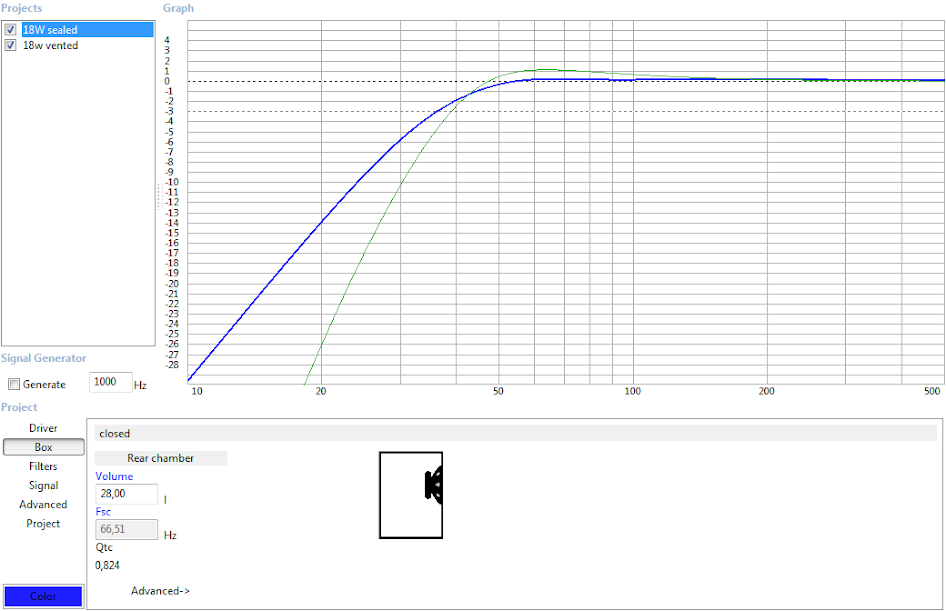
# eriksquires - Okay, good that they are big, then i am not stupid xD
#jReave - Hmm will have a closer looks but it sure did look wierd.. XP is also still the next-best OS for windows
It will be a good idea to run everything in a more advanced program than WinISD i guess. just need time to learn one of them.
But this chamfer style is a rather good one right?
Thanks for running those simulations!
So you are basically saying that the tweeter shouldn't get to close to the top of the cabinet right?
It does look better when the drivers are centered.. Is any offset better than none or do you need a certain amount of offset before it really matters?
Okay i understand.. i think i have an idea how to solve this now! I will post that later today or tomorrow! Hope you will also comment on that
Would you go apeiodic or not? I see that TG actually does not in the link you provided. But it sure does sound like he likes it!
I have now sealed off the tweeter completely. I new it was the right thing to do, just needed someone to tell me with authorityyyyyy..
I will try to post some more pictures and graphs toonight!
If i were to use two woofers in this cabinet as a sealed version, then i would achieve a Q of 0.8 (it seems from quick test in WinISD). By using parametric EQ's with these two sealed woofers in WinISD it seems like i can actually reach the same SPL's and a few Hz deeper bass extension than a single woofer in the ported cabinet of same size.
Does this sound realistic? (green is ported, blue is sealed with two drivers. Both speakers is reaching 103 dB SPL without the woofers traveling to far)
# eriksquires - Okay, good that they are big, then i am not stupid xD
#jReave - Hmm will have a closer looks but it sure did look wierd.. XP is also still the next-best OS for windows
It will be a good idea to run everything in a more advanced program than WinISD i guess. just need time to learn one of them.
But this chamfer style is a rather good one right?
Thanks for running those simulations!
So you are basically saying that the tweeter shouldn't get to close to the top of the cabinet right?
It does look better when the drivers are centered.. Is any offset better than none or do you need a certain amount of offset before it really matters?
Okay i understand.. i think i have an idea how to solve this now! I will post that later today or tomorrow! Hope you will also comment on that
Would you go apeiodic or not? I see that TG actually does not in the link you provided. But it sure does sound like he likes it!
I have now sealed off the tweeter completely. I new it was the right thing to do, just needed someone to tell me with authorityyyyyy..
I will try to post some more pictures and graphs toonight!
Last edited:
Hi Danner,
If you send me the TS data (or a link to the manufacturers site) on your proposed drivers I will run some sims for sealed box loading.
Re your DSP question, most DSP's allow you to Eq the bass or any frequency independent of the crossover filters.
What DSP are you using? Sorry I havent read the whole thread!
Cheers
Alex.
If you send me the TS data (or a link to the manufacturers site) on your proposed drivers I will run some sims for sealed box loading.
Re your DSP question, most DSP's allow you to Eq the bass or any frequency independent of the crossover filters.
What DSP are you using? Sorry I havent read the whole thread!
Cheers
Alex.
Alex, that would be awesome!
You can find The TS data of My 18w here:
Revelator – Scan-Speak A/S
I will be using one of the new fusion amps from hypex. Namely the FA123.
You can find The TS data of My 18w here:
Revelator – Scan-Speak A/S
I will be using one of the new fusion amps from hypex. Namely the FA123.
AND ---- To add to the confusion, here's an interesting article from Troels demonstrating a slightly different tuning with a bass reflex to get smaller enclosure size:
Illuminator-Monitor
Illuminator-Monitor
But this chamfer style is a rather good one right? So you are basically saying that the tweeter shouldn't get to close to the top of the cabinet right?
Indeed this chamfer style is very good. Your actual results are going to vary with how large you make the chamfer and how far they go down the sides of the baffle. And then on the driver positioning. Lower does indeed look better for the tweeter but you may be able to achieve something acceptable up higher too. Trial and error with quick cardboard facsimiles is the best way to go here. However, don't forget that the best height for the tweeter is also at your seated ear height or perhaps a little higher given your tilted baffle.
Just like the size of chamfers/radius edges, smaller changes in driver position mean smaller changes to the diffraction response. Again, you should be able to get very good results with all drivers centered.It does look better when the drivers are centered.. Is any offset better than none or do you need a certain amount of offset before it really matters?
Okay i understand.. i think i have an idea how to solve this now! I will post that later today or tomorrow! Hope you will also comment on thatWould you go apeiodic or not? I see that TG actually does not in the link you provided. But it sure does sound like he likes it!
Actually, take a closer look at Troels again. He mentions in 1 of the pic captions that a 35mm port was added to the upper mid chamber after photography took place. Unfortunately he doesn't mention the length but he stuffs it with a 60mm x 100mm sheet of acoustilux so it makes sense that's it's one of those 2 dimensions.
Now before you put in the effort on new sketches, perhaps a better idea for your mid chamber hit me this morning. Picture something like B&W's teardrop shape terminating with an open port but inside your woofer cabinet. There are at least several ways to construct it but I would think that something like a translam of MDF finishing into a 2" x 4" port would use up the minimum internal woofer volume while still allowing enough woofer airflow around the back and rear sides of the mid chamber. For more strength with a thin walled construction, I would probably wrap it in a sheet or 2 of fiberglass. I recently discovered how the end grain of MDF soaks in massive amounts of resin during this process thereby increasing strength even more. Now you have the option to go aperiodic with some lighter stuffing in the port similar to Troels, quasi aperiodic with heavier stufing before and inside the port or go sealed with heavy stuffing and closing the port of with a disc of wood. You have the flexibilty to decide which way you like it best here while at the same time using up as little internal volume as possible. Heavy damping on the inside of the chamber would also be recommended.
I have now sealed off the tweeter completely. I new it was the right thing to do, just needed someone to tell me with authorityyyyyy..

If i were to use two woofers in this cabinet as a sealed version, then i would achieve a Q of 0.8 (it seems from quick test in WinISD). By using parametric EQ's with these two sealed woofers in WinISD it seems like i can actually reach the same SPL's and a few Hz deeper bass extension than a single woofer in the ported cabinet of same size.
Does this sound realistic? (green is ported, blue is sealed with two drivers. Both speakers is reaching 103 dB SPL without the woofers traveling to far)
Whenever I have the choice between ported vs sealed, I will go sealed for 2 reasons. First, sealed has better transients. Better transients is another way of saying better clarity. And in the bass it's another way of saying tightness. Or (even though I kind of dislike using these terms) clean and fast. And second, you can use different stuffing strategies with sealed which means the rear energy is better absorbed. So less reflected sound coming back out through the cone, less energy to excite cabinet resonances and less sound transmission through cabinet walls. Again, more clarity.
So we've already established that those Hypexes can give you the necessary bass boost (or drop the rest of the FR for the same effect) and I trust Zaph enough to not question those woofers in a sealed alignment (I run the 15W sealed and it is just so sweet), so now it's a question of how much volume you have to play with. With Zaph's measured TS parameters, 38L gets you Q=.7 and 30L gets you Q=.8. I would prefer something closer to the 38L which would allow the use of more high density insulation to absorb more of the lower frequencies. Other people may be able to make their own suggestions. But don't forget that adding in lighter types of stuffing results in the driver 'seeing' a bigger box than actually exists.
Take note however that you aren't quite right about xmax and max SPL between ported and sealed. Above certain frequencies they will be equivalent but down at the lowest frequencies where we should be most concerned they are not going to be the same. You need to look at what the SPL is at xmax for each specific frequency. So using Unibox instead of WinISD, I've got 2 of the 18W's maxed out in 30L using Zaph's TS parameters in the graphs below. Follow the red line in the 1st graph. Max SPL's are going to be the following:
@ 20Hz = 86dB
@ 30Hz = 94dB
@ 40Hz = 98dB
@ 50Hz = 102dB
etc....
I've also included the difference in the impulse response between 30L vs 38L sealed and 38L ported tunes to 30Hz (1 driver only). I'll leave you to draw your own conclusions.
Attachments
-
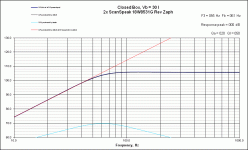 CB FR ScanSpeak 18W8531G Rev Zaph 30L.gif22.6 KB · Views: 43
CB FR ScanSpeak 18W8531G Rev Zaph 30L.gif22.6 KB · Views: 43 -
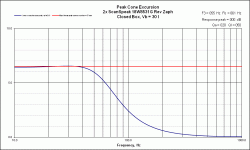 CB Excursion ScanSpeak 18W8531G Rev Zaph 30L.gif19.4 KB · Views: 41
CB Excursion ScanSpeak 18W8531G Rev Zaph 30L.gif19.4 KB · Views: 41 -
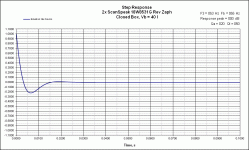 CB Step Response ScanSpeak 18W8531G Rev Zaph Q=.7.gif21.3 KB · Views: 51
CB Step Response ScanSpeak 18W8531G Rev Zaph Q=.7.gif21.3 KB · Views: 51 -
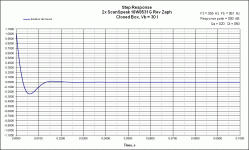 CB Step Response ScanSpeak 18W8531G Rev Zaph Q=.8.gif22 KB · Views: 51
CB Step Response ScanSpeak 18W8531G Rev Zaph Q=.8.gif22 KB · Views: 51 -
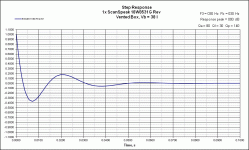 VB Step Response ScanSpeak 18W8531G Rev Zaph 38L.gif22.5 KB · Views: 46
VB Step Response ScanSpeak 18W8531G Rev Zaph 38L.gif22.5 KB · Views: 46
Sealed box sims for single & twin Scan Spk
Hey Danner,
Here are the sims.
To minimise the variables I have only changed the Sd (driver surface area) to give the closest like for like single Vs twin drivers.
Its the lower Q that really helps the twin drivers.... Basically the cone is only travelling one third the distance with the lower Q larger box volume.... This greatly reduces ( over 60% reduction) a host of distortions.
If you have bought the Scan Spks thats all good.
If you have not, I can suggest a few alternatives.
Cheers
A.
Hey Danner,
Here are the sims.
To minimise the variables I have only changed the Sd (driver surface area) to give the closest like for like single Vs twin drivers.
Its the lower Q that really helps the twin drivers.... Basically the cone is only travelling one third the distance with the lower Q larger box volume.... This greatly reduces ( over 60% reduction) a host of distortions.
If you have bought the Scan Spks thats all good.
If you have not, I can suggest a few alternatives.
Cheers
A.
Attachments
However, don't forget that the best height for the tweeter is also at your seated ear height or perhaps a little higher given your tilted baffle.
Oops, self edit. That should read:
... or perhaps even a bit lower given your tilted baffle.
#jReave - i was just about to ask why it should be above xD One of the reasons I am tilting it backwards is to mitigate the low tweeter height. However, now that i made it taler it might actually be pointing slightly above..
Good to know about the chamfer and driver location!
How exactly does these cardboard sims work? do you have any usefull links regarding this?
Yeah i read that he mentioned it, but i understood it as it was added later, after all the measurments and so on, so i think i confused with the 18WU..
Hehe waaaay ahead of you No but this morning i already changed the design to look like this:
No but this morning i already changed the design to look like this:
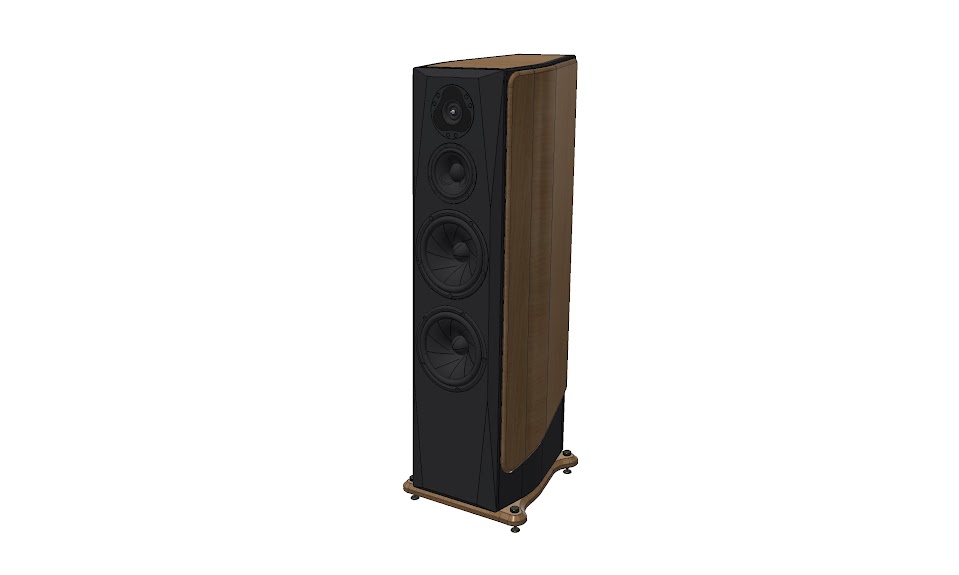

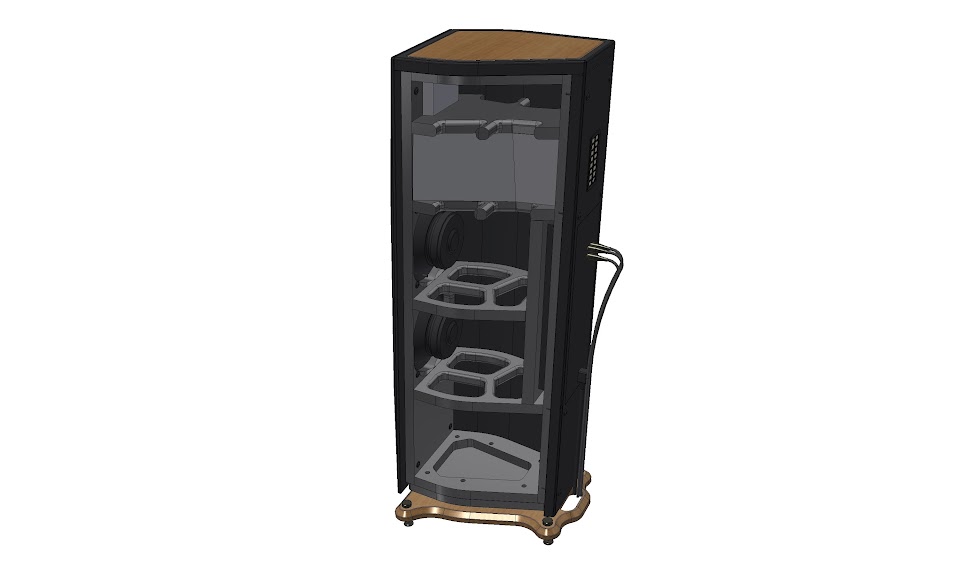


Kinda like what you describe right?
I love sketching, thats my second most favorite part of DIY projects.. i sketch everything i make
For simplicity i think i wil just keep the wall thickness the same.. unless you think my bass passage in the sides here are to narrow?
Yeah I like the flexibility of being able to try the different things out as my experience in sound is still fairly limited to say the least. So i may not really know what i yet prefer..
I have gotten hooked on the sealed system now as well.. It look sbadass with two woofers anyway and i am pretty sure the FA123 has plenty of power..
and i am pretty sure the FA123 has plenty of power..
with regard to cabinet size. would the 28l with some light stuffing be an acceptable compromise?
Hmm okay.. damit. i thought i understood it already.. Those sound levels are they at 1 m?
I usually listen below 85dB at 3-4m distance..
Thanks again for the elaborate explanations and work you have done!
# Alex - Thanks to you as well for the simulations! great for me to see what goes on!
I already have two 18W's at hand. So my plan was actually to try and build one speaker first to see if i am happy with it.
However, i am curious to hear if you know of other drivers that will match up or even beat them ?
Good to know about the chamfer and driver location!
How exactly does these cardboard sims work? do you have any usefull links regarding this?
Yeah i read that he mentioned it, but i understood it as it was added later, after all the measurments and so on, so i think i confused with the 18WU..
Hehe waaaay ahead of you
Kinda like what you describe right?
I love sketching, thats my second most favorite part of DIY projects.. i sketch everything i make
For simplicity i think i wil just keep the wall thickness the same.. unless you think my bass passage in the sides here are to narrow?
Yeah I like the flexibility of being able to try the different things out as my experience in sound is still fairly limited to say the least. So i may not really know what i yet prefer..
I have gotten hooked on the sealed system now as well.. It look sbadass with two woofers anyway
with regard to cabinet size. would the 28l with some light stuffing be an acceptable compromise?
Hmm okay.. damit. i thought i understood it already.. Those sound levels are they at 1 m?
I usually listen below 85dB at 3-4m distance..
Thanks again for the elaborate explanations and work you have done!
# Alex - Thanks to you as well for the simulations! great for me to see what goes on!
I already have two 18W's at hand. So my plan was actually to try and build one speaker first to see if i am happy with it.
However, i am curious to hear if you know of other drivers that will match up or even beat them ?
- Status
- This old topic is closed. If you want to reopen this topic, contact a moderator using the "Report Post" button.
- Home
- Loudspeakers
- Multi-Way
- 18W, 12M and R3004 active 3-Way
